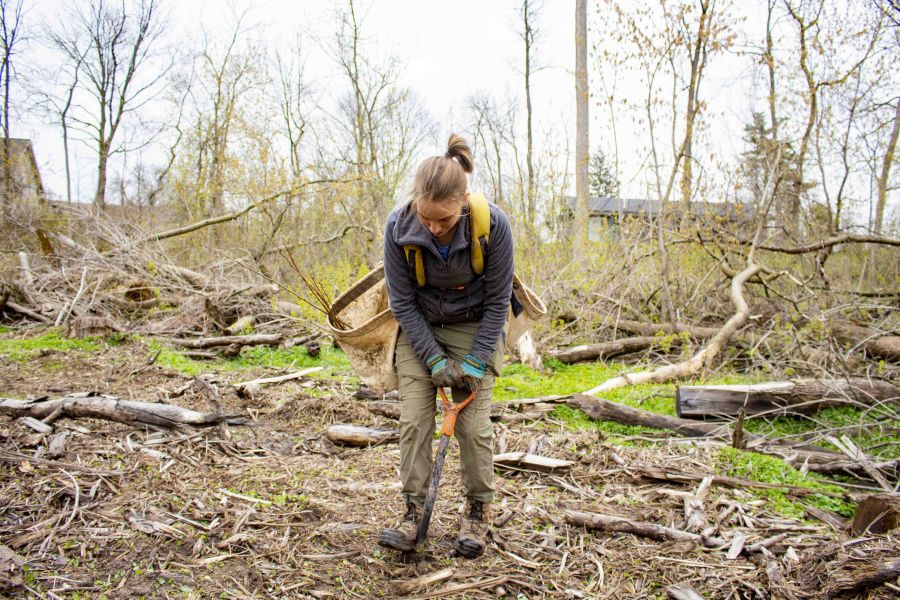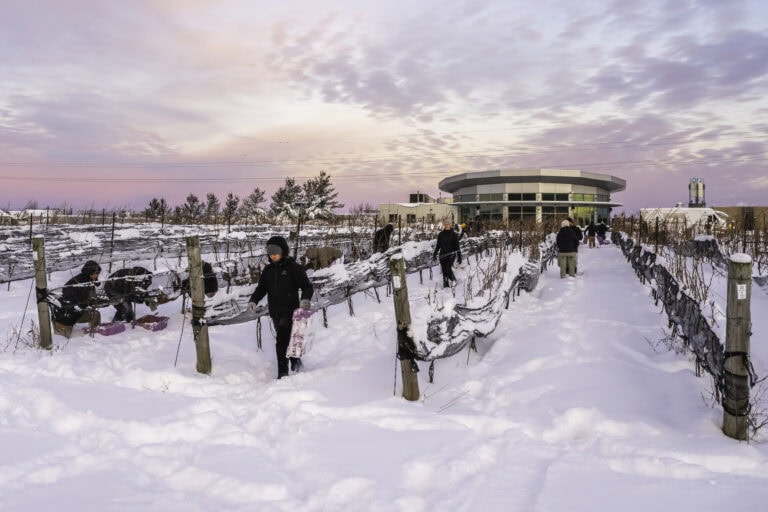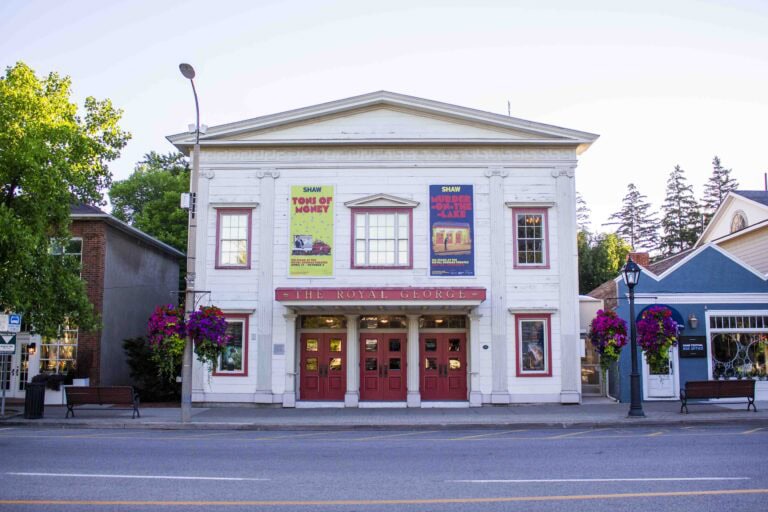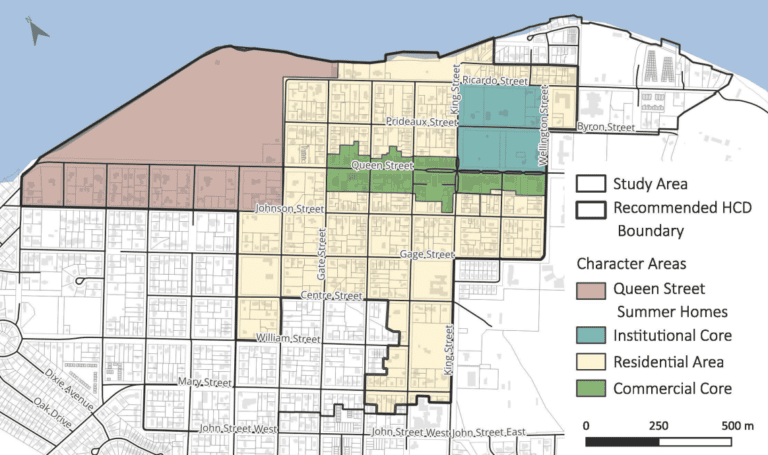Massive rehabilitation project essential for long-term health of the forest, conservation authority says
Less than a year after cutting down about 400 ash and maple trees along Two Mile Creek, the Niagara Peninsula Conservation Authority is hard at work replanting native, beneficial saplings in the area.
The Niagara-on-the-Lake project will ensure the creek area is much healthier than if it had been left alone, said Stuart McPherson, a restoration specialist with the authority.
“It’s a big change. But it was a necessary management change that needed to happen,” McPherson said in an interview Monday as the latest phase in the project began.
The work was a long time coming, as the ash trees that once dominated the creek started being devastated by the invasive emerald ash borer as early as 2012, said Dan Drennan, a watershed forester with the authority.
“This area was about 95 per cent ash,” he said.
“Four years it usually takes for them to start dying off. All the ash trees in here were dead.”
Doing work like this is beneficial for the health of the forest but also essential for protecting the safety of residents who use the trail.
“The tops were falling off of them,” Drennan said.
“It’s a big safety issue. People walk by here every day and it’s like, ‘Hey, it’s windy,’ and I don’t think twice about it and suddenly a tree falls on the path right in front of me,” McPherson said.
On Thursday, May 5, the conservation authority is encouraging residents to help with the final day of planting near the south end of Butler Street.
About 200 trees are reserved for residents who would like to take a personal hand in the health of their neighbouring forest and witness the work being done.
Residents who want to get involved should contact Kerry Royer at kroyer@npca.ca. The volunteer planting will take place between 10 a.m. and noon.
Drennan said the work had to start slowly last year as the unstable ash trees proved dangerous to the conservation workers.
But new life is springing up at a rate of about 1,000 trees per day this week.
Workers are planting quaking aspens, red maples, silver maples, sycamore, swamp white oak, red oak, bur oak, shagbark hickory and speckled alder.
McPherson explained some of the reasoning for choosing these particular trees.
“We picked these because it’s a good diversity of species but also because we are in kind of a valley,” he said,
“We're going to have a mixture of open canopy, where there are still some trees standing, and there’s also some sun as well.”
“These are trees that will establish quickly. There’s a good mix of trees that will kind of take off right away.”
“Some of our silver maples and trembling aspens, they’ll kind of act as almost nurse trees in a way for some of our trees that will take a little longer to establish,” said McPherson.
A nurse tree is a faster-growing species that will provide a stable habitat for slower-growing trees to flourish, he said.
He said the trees should get off to a good start, as Two Mile Creek has fertile soil.
“It’s a great spot to have trees.”
Residents may notice piles of bramble and mulch from the clear-cutting last year still in the creek area, but Drennan and McPherson said that’s not anything to worry about.
While much of the dead wood was removed, the conservation authority worried that using machinery to remove all of the wood would do more harm than good to the environment, Drennan said.
The wood that does remain will break down and make the soil of the creek even healthier. The piles also provide valuable habitat for small animals such as rabbits and squirrels.
One animal that does not use Two Mile Creek as a common habitat is the coyote, Drennan said.
“Coyotes are more of an edge species. This was a forest that had died off, so we weren’t disrupting coyote dens. We weren’t flushing coyotes out into the neighbourhood. That’s a myth.”
Amphibians and reptiles will also use the leftover wood as valuable living space, he said.
Mulch left behind by the grinding of dead trees last year also serves a valuable purpose for reigniting the health of Two Mile Creek.
“The mulch will break down and help keep more moisture in the ground so that when we get a hot summer day the trees will still have some moisture,” McPherson said.
The conservation authority had an ecologist take inventory of the creek last year to advise on how wildlife would be affected by the work.
One of the recommendations was the retention of some cavity trees – dead trees that provide hollow spaces for birds to roost and also create valuable habitat for bats.
The dead trees were left in spaces where they are within the forest, more sheltered from the wind and away from the trail, said McPherson.
He said the current issue with the emerald ash borer devouring trees across North America can be traced back to the forestry practices of 40 years ago.
Back then pines and ash were “planted everywhere because they grew very quickly and you saw results,” he said.
McPherson and Drennan said they understand residents' frustration regarding cutting in the forest, but ask for patience and understanding that what was done was necessary for the long-term sustainability of Two Mile Creek's ecological system.
And it will assuredly be as lush and green as it once was, McPherson said.
“It’s gonna take some time but we’re on the right path and it will get there and we’ll have a healthier environment for it,” he said.
After the planting is done the second phase of the project comes to an end. The third and final phase is simply monitoring the forest to ensure the trees grow well and to make necessary adjustments over time.
There are potential further plans in the works for Two Mile Creek, with McPherson saying rehabilitation of the creek bank is being considered, though nothing is finalized.
“We have to be sensitive just because there’s fish that spawn through this area,” he said.











